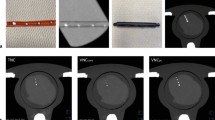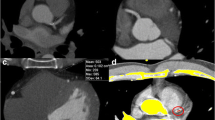Abstract
Purpose
Virtual non-contrast (VNC) coronary artery calcium scoring (CAC) may obviate the need for traditional non-contrast (TNC) CAC. There is no data on the influence of body mass index (BMI) on VNC reliability. We aimed to evaluate the influence of BMI on VNC CAC agreement with TNC.
Materials and methods
All patients who underwent sequential CAC and coronary CT angiography (CCTA) using spectral CT with TNC CAC > 0 between August 2020 and December 2021 were included. Agatston CAC scores were calculated manually by 2 blinded readers from VNC scans. A correction factor was calculated from the slope of the linear regression using the method of least squares and applied to the VNC scores. Bland-Altman plots and Cohen’s weighted Kappa were utilized.
Results
We included 174 patients (57.5% female). Mean BMI was 32.6 ± 7.02 kg/m2 [BMI < 30 (39.7%); BMI 30–40 (45.4%); and BMI > 40 kg/m2 (14.9%)]. Mean TNC CAC was 177.8 ± 316.86 and mean VNC CAC after applying the correction factor 149.34 ± 296.73. The TNC value strongly correlated with VNC (r = 0.94; p < 0.0001). As BMI increased there was a progressive reduction in signal-to-noise ratio, contrast-to-noise ratio and coronary enhancement (p < 0.05). The degree of agreement between VNC and TNC CAC decreased as BMI increased (agreement = 91.79 (weighted Kappa = 0.72), 91.14 (weighted Kappa = 0.58) and 88.46% (weighted Kappa = 0.48) (all P values < 0.001) for BMI < 30; 30–40 and > 40 kg/m2, respectively).
Conclusion
BMI has a significant influence on the accuracy of VNC CAC. VNC CAC shows substantial agreement in non-obese patients but performs poorly in BMI > 40 kg/m2.
Summary statement
This is the first study to evaluate the influence of body mass index (BMI) on virtual non-contrast (VNC) coronary artery calcium scoring (CAC) as compared to traditional non-contrast (TNC). We retrospectively evaluated 174 patients with TNC CAC and two blinded reviewers manually calculated the VNC CAC. All cases were included without specific selection for quality. The ratio between the two directly proportional values was determined using the slope from the linear regression through the method of least squares. This correction factor of 2.65 was applied to the calcium scores obtained from VNC images. We found that VNC CAC shows substantial risk-class agreement with TNC in non-obese patients (agreement = 91.79 and weighted Kappa = 0.72) but performs poorly in BMI > 40 kg/m2 (agreement: 88.46% and weighted Kappa = 0.48). These findings show the potential use of VNC CAC to avoid additional radiation in non-obese patients. However, further research on potential improvement strategies for VNC CAC in obese patients is needed.






Similar content being viewed by others
References
Bogers R, Bemelmans W, Hoogenveen R et al (2007) Association of overweight with increased risk of coronary heart disease partly independent of blood pressure and cholesterol levels.Archives of Internal Medicine. ; 167(16)
Ward ZJ, Bleich SN, Cradock AL et al (2019) Projected U.S. State-Level prevalence of adult obesity and severe obesity. N Engl J Med 381(25). https://doi.org/10.1056/nejmsa1909301
Karason K, Wikstrand J, Sjöström L, Wendelhag I (1999) Weight loss and progression of early atherosclerosis in the carotid artery: a four-year controlled study of obese subjects. Int J Obes 23(9). https://doi.org/10.1038/sj.ijo.0801024
Sjostrom L, Larsson B, Backman L et al (1992) Swedish obese subjects (SOS). Recruitment for an intervention study and a selected description of the obese state.International Journal of Obesity. ; 16(6)
Mangold S, Wichmann JL, Schoepf UJ et al (2016) Coronary CT angiography in obese patients using 3rd generation dual-source CT: effect of body mass index on image quality. Eur Radiol 26(9). https://doi.org/10.1007/s00330-015-4161-x
Gulati M, Levy PD, Mukherjee D et al (2021) 2021 AHA/ACC/ASE/CHEST/SAEM/SCCT/SCMR Guideline for the evaluation and diagnosis of chest Pain: a report of the American College of Cardiology/American Heart Association Joint Committee on Clinical Practice Guidelines. Circulation 144(22). https://doi.org/10.1161/cir.0000000000001029
Powell-Wiley TM, Poirier P, Burke LE et al (2021) Obesity and Cardiovascular Disease: A Scientific Statement from the American Heart Association. Circulation. https://doi.org/10.1161/CIR.0000000000000973
Greenland P, Bonow RO, Brundage BH et al (2007) ACCF/AHA 2007 Clinical Expert Consensus Document on Coronary Artery Calcium Scoring by computed tomography in Global Cardiovascular Risk Assessment and in evaluation of patients with chest Pain. A report of the American College of Cardiology Foundation Clinical Expert Consensus Task Force (ACCF/AHA writing Committee to Update the 2000 Expert Consensus Document on Electron Beam Computed Tomography). J Am Coll Cardiol. https://doi.org/10.1016/j.jacc.2006.10.001
Imai A, Komatsu S, Ohara T et al (2012) Visceral abdominal fat accumulation predicts the progression of noncalcified coronary plaque. Atherosclerosis 222(2). https://doi.org/10.1016/j.atherosclerosis.2012.03.018
Gassert FG, Schacky CE, Müller-Leisse C et al (2021) Calcium scoring using virtual non-contrast images from a dual-layer spectral detector CT: comparison to true non-contrast data and evaluation of proportionality factor in a large patient collective. Eur Radiol 31(8). https://doi.org/10.1007/s00330-020-07677-w
Yamada Y, Jinzaki M, Okamura T et al (2014) Feasibility of coronary artery calcium scoring on virtual unenhanced images derived from single-source fast kVp-switching dual-energy coronary CT angiography. J Cardiovasc Comput Tomogr 8(5). https://doi.org/10.1016/j.jcct.2014.08.005
Agatston AS, Janowitz WR, Hildner FJ, Zusmer NR, Viamonte M, Detrano R (1990) Quantification of coronary artery calcium using ultrafast computed tomography. J Am Coll Cardiol 15(4). https://doi.org/10.1016/0735-1097(90)90282-T
Ghoshhajra BB, Engel LC, Major GP et al (2011) Direct chest area measurement: a potential anthropometric replacement for BMI to inform cardiac CT dose parameters? J Cardiovasc Comput Tomogr 5(4). https://doi.org/10.1016/j.jcct.2011.06.003
Trattner S, Halliburton S, Thompson CM et al (2018) Cardiac-specific Conversion factors to Estimate Radiation Effective Dose from dose-length product in computed tomography. JACC: Cardiovasc Imaging 11(1). https://doi.org/10.1016/j.jcmg.2017.06.006
Khera R, Pandey A, Ayers CR et al (2020) Performance of the pooled cohort equations to Estimate Atherosclerotic Cardiovascular Disease Risk by Body Mass Index. JAMA Netw Open 3(10). https://doi.org/10.1001/jamanetworkopen.2020.23242
Litwin SE, Coles A, Hill CL et al (2020) Discordances between predicted and actual risk in obese patients with suspected cardiac ischaemia. Heart 106(4). https://doi.org/10.1136/heartjnl-2018-314503
Investigators S-H (2018) Coronary CT angiography and 5-year risk of myocardial infarction.New England Journal of Medicine.
Sharma A, Coles A, Sekaran NK et al (2019) Stress testing versus CT angiography in patients with diabetes and suspected coronary artery disease. J Am Coll Cardiol 73(8). https://doi.org/10.1016/j.jacc.2018.11.056
Ahmed AI, Han Y, al Rifai M et al (2021) Added prognostic value of plaque burden to computed tomography angiography and myocardial perfusion imaging. Atherosclerosis 334. https://doi.org/10.1016/j.atherosclerosis.2021.08.032
Williams MC, Kwiecinski J, Doris M et al (2020) Low-attenuation Noncalcified Plaque on Coronary computed Tomography Angiography predicts myocardial infarction: results from the Multicenter SCOT-HEART Trial (Scottish Computed Tomography of the HEART). Circulation. https://doi.org/10.1161/CIRCULATIONAHA.119.044720
Williams MC, Moss AJ, Dweck M et al (2019) Coronary artery plaque characteristics Associated with adverse outcomes in the SCOT-HEART Study. J Am Coll Cardiol 73(3). https://doi.org/10.1016/j.jacc.2018.10.066
Cury RC, Leipsic J, Abbara S et al (2022) the American College of Cardiology (ACC), the American College of Radiology (ACR) and the North America society of cardiovascular imaging (NASCI). J Cardiovasc Comput Tomogr. https://doi.org/10.1016/j.jcct.2022.07.002. CAD-RADS™ 2.0–2022 Coronary Artery Disease – Reporting and Data System an expert consensus document of the Society of Cardiovascular Computed Tomography (SCCT)
Williams MC, Earls JP, Hecht H (2021) Quantitative assessment of atherosclerotic plaque, recent progress and current limitations. J Cardiovasc Comput Tomogr. https://doi.org/10.1016/j.jcct.2021.07.001
Messerli FH (2019) Ephemeral Coronary Heart Disease. Eur Heart J 40(24). https://doi.org/10.1093/eurheartj/ehz400
Schoepf UJ, Colletti PM (2012) New dimensions in imaging: the awakening of dual-energy CT. AJR Am J Roentgenol. https://doi.org/10.2214/ajr.12.9119
Nadjiri J, Kaissis G, Meurer F et al (2018) Accuracy of Calcium Scoring calculated from contrast-enhanced Coronary computed Tomography Angiography using a dual-layer spectral CT: a comparison of Calcium Scoring from real and virtual non-contrast data. PLoS ONE 13(12). https://doi.org/10.1371/journal.pone.0208588
Schwarz F, Nance JW, Ruzsics B, Bastarrika G, Sterzik A, Schoepf UJ (2012) Quantification of coronary artery calcium on the basis of dual-energy coronary CT angiography. Radiology 264(3). https://doi.org/10.1148/radiol.12112455
Layritz C, Muschiol G, Flohr T et al (2013) Automated attenuation-based selection of tube voltage and tube current for coronary CT angiography: reduction of radiation exposure versus a BMI-based strategy with an expert investigator. J Cardiovasc Comput Tomogr 7(5). https://doi.org/10.1016/j.jcct.2013.08.010
Einstein AJ, Henzlova MJ, Rajagopalan S (2007) Estimating risk of cancer associated with radiation exposure from 64-slice computed tomography coronary angiography. J Am Med Assoc 298(3). https://doi.org/10.1001/jama.298.3.317
Gopal A, Budoff MJ (2009) A new method to reduce radiation exposure during multi-row detector cardiac computed tomographic angiography. Int J Cardiol 132(3):435–436. https://doi.org/10.1016/j.ijcard.2007.08.072
Funding
No funding was received.
Author information
Authors and Affiliations
Contributions
All authors contributed in the design, analysis and presentation of the data and contributed to the writing of the manuscript.
Corresponding author
Ethics declarations
Conflict of interest
LS has received consulting honoraria from Phillips.
Additional information
Publisher’s Note
Springer Nature remains neutral with regard to jurisdictional claims in published maps and institutional affiliations.
IRB: The study was approved by our Institutional Review Board (Office of Human Research Affairs at Albert Einstein College of Medicine) and was HIPAA compliant.
Presented in part at SCCT Annual Scientific Meeting in Las Vegas, NV, July 15-17th, 2022.
Rights and permissions
Springer Nature or its licensor (e.g. a society or other partner) holds exclusive rights to this article under a publishing agreement with the author(s) or other rightsholder(s); author self-archiving of the accepted manuscript version of this article is solely governed by the terms of such publishing agreement and applicable law.
About this article
Cite this article
Perez-Cervera, J., Arce, J., Fattouh, M. et al. Influence of BMI on virtual coronary artery calcium scoring. Int J Cardiovasc Imaging 39, 863–872 (2023). https://doi.org/10.1007/s10554-022-02785-8
Received:
Accepted:
Published:
Issue Date:
DOI: https://doi.org/10.1007/s10554-022-02785-8




